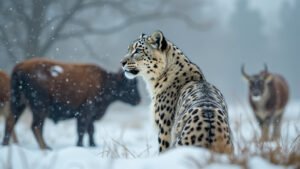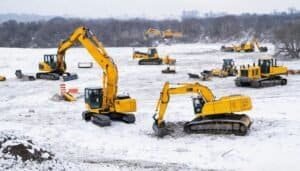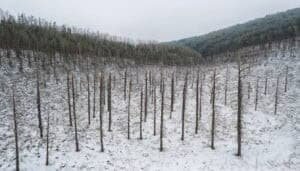Introduction
Climate change poses a significant threat to snow leopards, an already vulnerable species adapted to the harsh, mountainous environments of Central and South Asia. This article will explore the multifaceted impacts of climate change on snow leopards, including alterations to their habitat, shifts in prey availability, behavioral changes due to rising temperatures, and the escalation of human-wildlife conflict
Additionally, we’ll discuss current conservation efforts and adaptation strategies aimed at mitigating these threats. Understanding these dynamics is crucial for developing effective measures to protect snow leopards in a rapidly changing climate
How Climate Change Alters Snow Leopard Habitat
Climate change has profound effects on the habitats of snow leopards, which are primarily located in the high mountain ranges of Central and South Asia. As temperatures rise and weather patterns shift, the delicate balance of these ecosystems is disrupted, directly threatening the survival of these elusive big cats
Shrinking Glaciers and Snow Cover
Snow leopards thrive in cold, high-altitude environments where snow cover and glaciers are essential components of their habitat. Rising global temperatures have accelerated the melting of glaciers and reduced snow cover in these regions
According to a study by the World Wildlife Fund (WWF) in 2020, the Himalayan glaciers have been retreating at an alarming rate, losing nearly one-third of their ice mass since the 1970s. This loss of ice and snow diminishes the snow leopards’ hunting grounds and affects the availability of water resources, which are vital for their prey species as well
Changes in Vegetation and Prey Patterns
As temperatures rise, the composition of vegetation in snow leopard habitats changes. Warmer conditions allow lower-altitude plant species to migrate upward, altering the local flora and affecting the herbivorous prey that snow leopards rely on, such as blue sheep and ibex
A 2018 study published in Global Change Biology found that climate-induced vegetation changes can lead to a decline in suitable habitat for these prey species, thus reducing the food available for snow leopards
This shift not only impacts the prey population but also forces snow leopards to expand their range in search of food, increasing the likelihood of human-wildlife conflict
Impact on Breeding and Denning Sites
Snow leopards require specific environmental conditions for breeding and denning, typically favoring rocky outcrops and caves that offer protection from the elements and predators. Climate change can alter these conditions, making traditional denning sites less suitable
For instance, increased precipitation in the form of rain rather than snow can lead to flooding and erosion of these sites, as noted in a 2019 report by the International Union for Conservation of Nature (IUCN). Such changes can disrupt breeding cycles and reduce cub survival rates, further endangering the species.
The alteration of snow leopard habitats due to climate change is a complex issue that intertwines with other environmental and anthropogenic factors. Conservation efforts must therefore be multifaceted, addressing not only the direct impacts of climate change but also the broader ecological changes that affect snow leopard populations
Effects on Prey Availability
The availability of prey is critical for the survival of snow leopards, and climate change significantly disrupts these dynamics
Snow leopards primarily prey on ungulates such as blue sheep (bharal) and ibex, which are also affected by the changing climate. Understanding the intricate relationships between snow leopards and their prey highlights the broader ecological impacts of climate change
Decline in Prey Populations
Climate change affects the distribution and population dynamics of prey species, leading to potential declines in their numbers. Warmer temperatures and altered precipitation patterns can degrade the alpine meadows and grasslands that are crucial for the herbivorous prey of snow leopards
According to a study published in Biological Conservation in 2017, the reduction in suitable habitats for prey species due to climate change can lead to significant population declines. This decline directly impacts snow leopards, forcing them to expend more energy in search of food, which can reduce their overall fitness and reproductive success
Altered Prey Migration Patterns
As climate conditions change, the migratory patterns of prey species can also shift. These shifts can result in prey moving to areas that are less accessible or completely outside the traditional range of snow leopards
A 2015 study in the Journal of Wildlife Management found that changes in the availability and location of prey due to climate change can force snow leopards to travel greater distances to find food, increasing their vulnerability to starvation and human conflict. These altered patterns can disrupt the delicate balance of predator-prey interactions, making it more difficult for snow leopards to sustain their populations
Competition with Other Predators
Climate change can also alter the interactions between snow leopards and other predators. As prey species migrate or become scarce, snow leopards may face increased competition from other carnivores such as wolves and domestic dogs
A 2020 study published in Global Ecology and Conservation highlighted that such competition can lead to direct confrontations and decreased prey availability for snow leopards. This increased competition not only threatens the food security of snow leopards but also heightens the risk of injuries or fatalities from interspecies conflicts
The effects of climate change on prey availability present significant challenges for snow leopards. Conservation strategies must consider these impacts, focusing on preserving and restoring prey populations and habitats to ensure the long-term survival of snow leopards in a changing climate
Temperature Rise and Snow Leopard Behavior
Rising temperatures due to climate change affect snow leopard behavior in several ways. These big cats, adapted to cold environments, face new challenges as their habitat warms. Understanding these behavioral changes is crucial for developing effective conservation strategies
Adaptation Challenges
Snow leopards are physiologically adapted to cold, high-altitude environments. With rising temperatures, they must adapt to conditions outside their optimal range
A study by the Snow Leopard Trust in 2019 noted that snow leopards are forced to move to higher altitudes in search of cooler habitats, which can be limited and less suitable for their needs. This upward migration reduces their available habitat and increases competition for resources with other high-altitude species
Changes in Hunting Strategies
Warmer temperatures and changing prey availability require snow leopards to adapt their hunting strategies. As prey species move or decline, snow leopards may need to hunt more frequently or target different species
According to a 2017 study in the Journal of Animal Ecology, snow leopards might shift from their usual solitary hunting to more opportunistic behaviors, including scavenging or hunting livestock. These changes can increase the risk of human-wildlife conflict and impact the health and nutrition of snow leopards
Increased Energy Expenditure
Adapting to a warmer climate and changing prey dynamics requires more energy. Snow leopards may need to travel longer distances to find food, water, and suitable habitats. This increased energy expenditure can reduce their overall fitness and reproductive success
A 2020 report by the World Wildlife Fund (WWF) highlighted that snow leopards in regions with significant habitat changes show signs of stress and decreased body condition, indicating the energy costs of adapting to climate change
The impact of rising temperatures on snow leopard behavior underscores the need for targeted conservation efforts that address the specific challenges posed by a warming climate. Ensuring the survival of snow leopards requires a comprehensive understanding of how these behavioral changes affect their long-term viability
Human-Wildlife Conflict
As climate change alters the natural habitats and behaviors of snow leopards, interactions with humans become more frequent and often more contentious
These conflicts can arise from various factors, including habitat encroachment, competition for resources, and livestock depredation. Understanding and mitigating human-wildlife conflict is essential for the conservation of snow leopards
Increased Livestock Depredation
With their natural prey becoming scarce due to climate change, snow leopards may turn to livestock as an alternative food source. This shift is driven by the easier accessibility of livestock compared to their dwindling wild prey
A study by the Snow Leopard Network in 2018 found that in areas where prey populations have declined, instances of snow leopards preying on livestock have increased significantly. This leads to economic losses for local herders and fosters negative attitudes toward snow leopards, often resulting in retaliatory killings
Human Encroachment and Habitat Fragmentation
As human populations grow and expand into snow leopard habitats, the natural landscapes that these big cats rely on become fragmented. This encroachment reduces the available habitat for snow leopards and increases the likelihood of encounters with humans
The Global Snow Leopard & Ecosystem Protection Program (GSLEP) reported in 2020 that infrastructure development, such as roads and settlements, disrupts migration corridors and breeding grounds, further exacerbating human-wildlife conflict
This fragmentation not only limits the space available for snow leopards but also isolates populations, making it harder for them to find mates and maintain genetic diversity
Mitigation Strategies
Addressing human-wildlife conflict requires a multifaceted approach that balances the needs of local communities with conservation goals. Community-based initiatives have proven effective in mitigating conflict
Programs that compensate herders for livestock losses, improve livestock management practices, and provide alternative livelihoods can reduce the economic burden on local communities and foster coexistence. For instance, the Snow Leopard Trust’s Livestock Insurance Program compensates herders for losses due to snow leopard predation, reducing the incentive for retaliatory killings
Additionally, conservation organizations are working to create and maintain wildlife corridors that allow snow leopards to move safely between fragmented habitats. Efforts to involve local communities in conservation activities, such as monitoring snow leopard populations and educating them about the ecological importance of these predators, are also crucial
A 2019 study in Conservation Biology emphasized that empowering local communities and incorporating traditional knowledge into conservation strategies can enhance the effectiveness of these efforts
Human-wildlife conflict is a significant challenge in the conservation of snow leopards, exacerbated by the impacts of climate change. By implementing comprehensive mitigation strategies and fostering community involvement, it is possible to reduce conflicts and support the long-term survival of snow leopards
Conservation Efforts and Adaptation
The impact of climate change on snow leopards necessitates robust and adaptive conservation strategies. These strategies must address the immediate threats posed by climate change while also building long-term resilience for snow leopard populations and their habitats
Climate-Resilient Conservation Strategies
Developing climate-resilient conservation strategies involves anticipating future climate scenarios and their potential impacts on snow leopard habitats. Conservation organizations are increasingly using climate modeling to predict changes in snow leopard distribution and habitat suitability
A 2020 study by the International Union for Conservation of Nature (IUCN) highlighted the importance of integrating climate data into conservation planning to ensure that protected areas remain viable habitats for snow leopards under future climate conditions. This includes identifying and protecting climate refugia—areas that are expected to remain relatively stable despite climate change
Community Involvement and Education
Engaging local communities in conservation efforts is critical for the success of any strategy aimed at protecting snow leopards. Community-based conservation programs empower local people to take an active role in monitoring and protecting snow leopards and their habitats
For example, the Snow Leopard Conservancy’s “Citizen Science” program trains local residents to conduct wildlife surveys and monitor snow leopard populations. Such involvement not only enhances data collection but also fosters a sense of stewardship among community members
Educational initiatives are also vital. Raising awareness about the importance of snow leopards and the challenges they face can help garner local support for conservation measures. Programs that educate herders and farmers about non-lethal methods to protect livestock from predation, such as using guard dogs and improved corral designs, can reduce human-wildlife conflict and promote coexistence
Policy and International Collaboration
Effective snow leopard conservation requires strong policy frameworks and international collaboration
The Global Snow Leopard & Ecosystem Protection Program (GSLEP) is a notable example of such collaboration, bringing together the 12 countries within the snow leopard range to work towards common conservation goals. This initiative focuses on securing 23 priority landscapes by 2020 and emphasizes transboundary cooperation to manage and protect snow leopard habitats that span national borders
National governments play a crucial role in enforcing laws and regulations that protect snow leopards and their habitats. Strengthening legal protections against poaching and habitat destruction, and ensuring that these laws are effectively implemented, is essential
Additionally, securing funding for conservation projects and ensuring that resources are allocated efficiently can enhance the impact of conservation efforts
By incorporating climate-resilient strategies, engaging local communities, and fostering international collaboration, conservation efforts can be more adaptive and effective in mitigating the threats posed by climate change. These comprehensive approaches are essential for ensuring the long-term survival of snow leopards in a rapidly changing world
Conclusion
Climate change presents a significant threat to snow leopards, impacting their habitat, prey availability, behavior, and interactions with humans. As glaciers and snow cover shrink, the habitat of snow leopards becomes less suitable, forcing them to adapt to changing environmental conditions
This includes shifts in their hunting strategies and increased energy expenditure, further straining their survival. The scarcity of prey leads to increased livestock depredation, which heightens human-wildlife conflict
However, through targeted conservation efforts, including climate-resilient strategies, community involvement, and international collaboration, there is hope for mitigating these impacts. By understanding and addressing the multifaceted effects of climate change on snow leopards, we can develop effective measures to ensure their long-term survival











